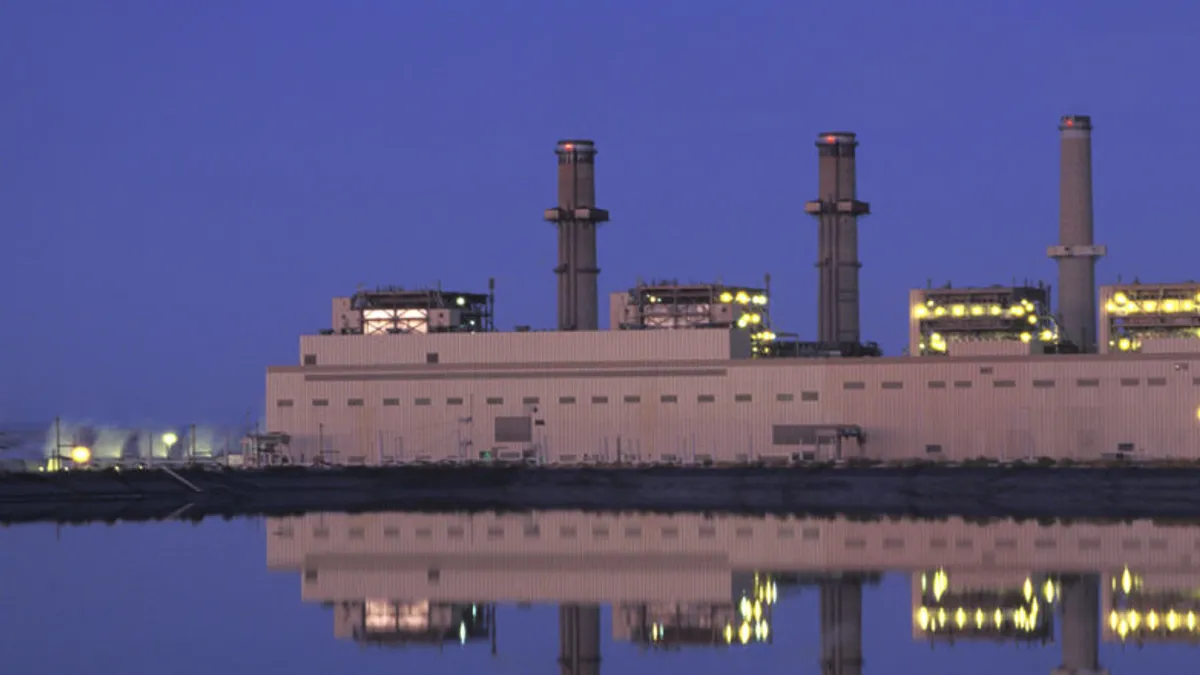Dive Brief:
- Public Service Company of New Mexico (PNM) on Monday filed its application to retire the San Juan Generating Station coal-fired plant in 2022, giving state regulators four separate replacement scenarios.
- The first scenario, which PNM described as the lowest cost to customers, would add 280 MW of natural gas peaking units at the San Juan plant site, along with 350 MW of solar capacity and 130 MW of battery storage capacity. The utility expects a capital investment of $733 million to add the new generation, which PNM says would reduce carbon dioxide emissions by 62% and save customers $7.11 per month in 2023 compared with continued operation of the coal plant.
- PNM owns two thirds of the San Juan plant and reached an agreement with minority stakeholders, including Tucson Electric Power, to retire the remaining units in June 2022. The utility will have a lengthy stakeholder process with New Mexico's Public Regulation Commission (PRC) to determine the replacement plan, PNM spokesperson Ray Sandoval told Utility Dive.
Dive Insight:
Prompted in part by the state's Energy Transition Act passed earlier in March, the utility offered scenarios that would preserve system reliability, reduce emissions and offer savings to customers. The bill set New Mexico on track to have 100% clean energy by 2050.
However, climate groups such as the Sierra Club took issue with the utility's proposal to add new natural gas capacity.
PNM modeled a separate scenario with only renewables, which would cost customers another $5.46 per month in 2023, and a plan without fossil fuels, which included 410 MW of battery storage that would save customers less than $0.50 per month in the first year after San Juan retired.
"We know there [are] models out there that say this would work," Sandoval said, referring to fossil fuel-free replacement options. "But we would have to do 410 MW of battery storage, and that's a percentage of our peak load we felt uncomfortable doing at this time."
He said the battery market's prices are expected to drop and the duration of the products is expected to improve, which would make the transition to a larger amount of storage more advantageous to the utility.
One aspect that utility, consumer and climate advocates can agree on is that the most expensive option would be to continue operating San Juan's coal-burning units. PNM received approval in December for its integrated resource plan to phase out coal-fired generation by 2031.
The utility already has 140 MW of wind resources pending approval in its Renewable Portfolio Case. That capacity and an additional 20 MW of solar that the utility proposed to site at San Juan, in place of the two units retired in 2017, are also part of the San Juan replacement scenarios.
The lowest cost scenario, with 280 MW of new gas, "saves PNM customers over $80 million in 2023. This is all done pursuant to the recently passed Energy Transition Act and shows how good outcomes can be achieved when people work together to solve problems," Steve Michel, deputy director of Western Resource Advocates' Clean Energy Program, said in a statement.
To smooth the transition for the communities affected by the coal plant's closure, PNM requested the authority to issue $361 million of "energy transition bonds," which must be repaid across its entire customer base in order for the utility to cover its debt, decommissioning costs and fund severance pays, and workforce trainings, according to an 8-K Form filed on Monday. PNM forgave $109 million of debt "to make the transition easier for our customers," Sandoval said.
The following capacity and costs are associated with the additions of PNM's cheapest scenario:
| Project | Resource | Nameplate Capacity | Capital Investment | County |
|---|---|---|---|---|
| Clenera Arroyo Solar Project | Solar | 300 MW | $360M | McKinley |
| Clenera Arroyo Storage Project | Battery | 40 MW, 160 MWh | (part of above)° | McKinley |
| Jicarilla 1 Solar Project | Solar | 50 MW | $70M | Rio Arriba |
| Jicarilla Storage Project | Battery | 20 MW, 80 MWh | (part of above)° | Rio Arriba |
| Piñon Generating Station and Transmission Line | Natural Gas | 280 MW | $212.3M* | San Juan |
| Sandia Storage Project | Battery | 40 MW, 80 MWh | $50.5M | Bernalillo |
| Zamora Storage Project | Battery | 30 MW, 60 MWh | $40.3M | Bernalillo |
°PNM combined project cost for the solar and storage components.
*Generating station construction is estimated at $192.3 million and transmission line at $20 million.
PNM had previously suggested a 456 MW addition of gas to meet reliability requirements. Although the gas capacity has been reduced, climate advocates like Sierra Club have noted that all-clean energy resources will be better options.
"The commission process will provide opportunities for us to analyze the best mix of replacement power," Camilla Geibelman, Sierra Club's Rio Grande chapter director, said in a statement.
Sierra Club published a study in February suggesting that the gas capacity could be substituted by cleaner resources for less cost: 300 MW of solar, 180 MW of utility-scale storage and 19 MW of demand response. The plan did not include wind resources.
"There is a good amount of wind on the system already, so bringing in solar sort of diversifies the system," Geibelman told Utility Dive.















